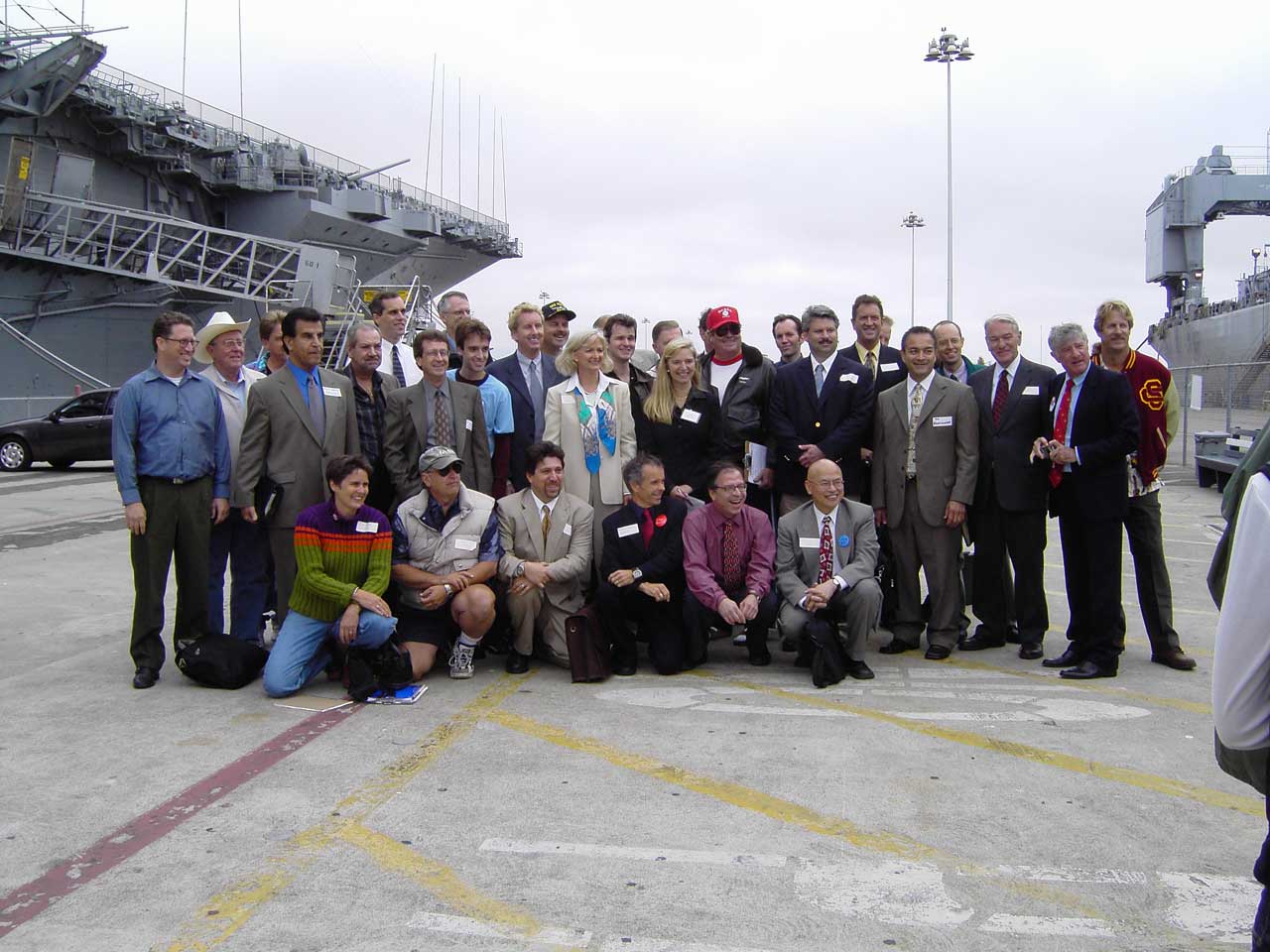Friday, December 02, 2005
Ask The Professor
A friend and climate-change skeptic, W., quizzes J., a professor of climatology, about the state of climatology. As I understand it, in the last 25 years, there has been a shift away from chemical explanations for climate change (carbon sequestration in the oceans, as affected by carbonate/bicarbonate sensitivity to temperature), and a shift towards thermohaline circulation sensitivity towards salinity. Presumably the fairly-rapid temperature changes of the Pleistocene can't be explained by deep oceanic processes, which don't change that rapidly. For other, probably more authoritative answers, J. suggests Realclimate.org.
W. writes:
Hey Marc: Got some questions about climate change / global warming. Back in 1990 I taught a night school course for teachers on Climate Change (textbook was Schneider & Londer). I've lost track with the thinking, but now I want to catch up somewhat. So here are the questions:
1.) As of 1990, climatic variation on a scale of 1-10 years was becoming understood in terms of ENSO. Variation on a scale of 10,000-100,000 years was well understood as Milankovitch cycles. But variation on time scales of 10-10,000 years was not understood much at all. There was speculation of CO2 sequestration and release in vertical ocean convections. What is the present interpretation of this time scale? Something in one of your recent emails made me think the vertical ocean circulation has been successful.
J. answers:
J. answers:
J. answers:
J. answers:
Link
A friend and climate-change skeptic, W., quizzes J., a professor of climatology, about the state of climatology. As I understand it, in the last 25 years, there has been a shift away from chemical explanations for climate change (carbon sequestration in the oceans, as affected by carbonate/bicarbonate sensitivity to temperature), and a shift towards thermohaline circulation sensitivity towards salinity. Presumably the fairly-rapid temperature changes of the Pleistocene can't be explained by deep oceanic processes, which don't change that rapidly. For other, probably more authoritative answers, J. suggests Realclimate.org.
W. writes:
Hey Marc: Got some questions about climate change / global warming. Back in 1990 I taught a night school course for teachers on Climate Change (textbook was Schneider & Londer). I've lost track with the thinking, but now I want to catch up somewhat. So here are the questions:
1.) As of 1990, climatic variation on a scale of 1-10 years was becoming understood in terms of ENSO. Variation on a scale of 10,000-100,000 years was well understood as Milankovitch cycles. But variation on time scales of 10-10,000 years was not understood much at all. There was speculation of CO2 sequestration and release in vertical ocean convections. What is the present interpretation of this time scale? Something in one of your recent emails made me think the vertical ocean circulation has been successful.
J. answers:
It depends on which period you're interested in. In the late Pleistocene, the large temperature fluctuations that occurred were probably caused because of an instability in the Laurentide Ice Sheet (the big one that covered most of Canada). Basically the idea here is that influxes of freshwater into the North Atlantic and the subsequent reduction in the salinity of the surface waters caused a weakening in the North Atlantic thermohaline circulation, thus reducing heat transport into the high latitudes of the Northern Hemisphere. (One example: the Younger Dryas Event, which may have been caused by a sudden re-direction of water from glacial Lake Agassiz.2.) In 1990, the big unknown in climatic modelling was albedo change due to cloud cover -- will warming result in positive or negative feedback? You seemed to say that this was still an unknown. Is this correct? If so, how much confidence do you have in all the models which predict significant warming over the next century?
In the Holocene, the amplitude of temperature changes has been much smaller; various possible mechanisms have been proposed as causes: changes in solar energy flux, increased albedo due to volcanic eruptions, and "internal variability" of the climate system, e.g., things like ENSO, PDO, etc. Nothing definitive, though, as far as I can tell. (Reconstructions of solar-energy flux are very dubious; they are essentially extrapolations based on a rather meager dataset -- 25 years of satellite measurements.)
J. answers:
There are two main sources of uncertainty: (1) future anthropogenic emissions of greenhouse gases and (2) the effect of cloud feedbacks. For a given emissions scenario, it is still true that the biggest source of uncertainty is the cloud feedback. The latest model intercomparison study that I have seen still shows that the feedback is positive in some and negative in others.3.) In 1990, when talking with believers in anthropogenic warming who pointed to demonstrated warming since 1850 (correlating with the Industrial Revolution), I would counter by saying one could interpret the present warming regime as beginning around 1700, when the Little Ice Age began to let up. In that case, the warming would predate the Industrial Revolution, and would therefore require a different (or at least an additional) cause. Nobody ever satisfactorily rebutted my argument at that time. How would you answer that today?
"Confidence"? Hard to say. There is such a range in model sensitivities and of emissions scenarios that it seems likely that the future warming is encompassed by the projections that have been made. The lowest projected temperature rise, made using the least sensitive model (one in which the cloud feedback is strongly negative) and the lowest credible emissions scenario (in which emissions in 2100 are actually lower than 1980 values) is 1.5 degrees C.
J. answers:
What you're really talking about here is how the warming of the past century or so compares with natural variability. Climate models that are given constant forcing (e.g., constant solar flux) exhibit a century-scale variability of only a few tenths of a degree C, considerably less than the 0.6 deg. warming that has been observed. In addtion, temperature reconstructions using proxy climate data (e.g., Mann, Bradley, and Hughes) indicate that temperature increase of the 20th century is much greater than the variability over the period 1000-1900. (This study has stood up well to recent attacks, e.g., by McIntyre and McKitrick; I recommend the the discussion at Realclimate.org for more details.)4.) In 1990 I was not aware of any good theories for the Little Ice Age and the Medieval Maximum. Are there explanations now?
J. answers:
I go back to the reconstructions mentioned in #3, which indicate that the amplitude of global mean temperatures on time scales of centuries was probably only a few tenths of a degree prior to 1900; this is considerably less than some early estimates that were based on much sparser data. So, statements that indicate that the global mean temperature in the middle ages was a degree or more than today's temperature would appear to be unfounded. It seems to me that the "Little Ice Age" is essentially a period in which the Earth was somewhat colder than today. It may be that part of the warming since then (e.g., in the early 20th century) was due to natural causes, but when all of the data and model results are taken together, the preponderance of evidence supports the thesis that most of the warming has been caused by the observed increase in anthropogenic greenhouse gases. This is especially true of the last several decades; there has been a 45 ppm increase in CO2 concentrations since 1975 and an increase in global surface temperature of nearly half a degree Celsius during that time. (These are essentially the only climate-related variables that have shown a large increase over that time.)
Link
Dreams, and The Laboon
How one of the Moken (the Sea Gypsies of Thailand) survived a year ago:
Link
How one of the Moken (the Sea Gypsies of Thailand) survived a year ago:
John then asks Salama of his own experiences nearly a year ago. Salama pauses, then describes a series of dreams he had before the Laboon, as the Moken call the tsunami. Three nights before he had his first dream, in which he saw the sea turn blood red and watched a western woman struggle in the waves. When he woke, he turned and prayed to the sea that it not be too harsh.
The second night the dream repeated, and when he told his wife she dismissed his premonition, saying he had too much to eat and drink.
The third night the dream happened again, and Salama was convinced nature was angry. The Moken legends tell that the sea sends in a Laboon every once in a great while to clean up what has become dirty, and Salama knew his village was not clean. He lamented that the young people had been leaving the island for the mainland allures, and returned with trash, which was littering the once pristine beach. He said he knew that morning that the sea was coming to wash his village.
He first noticed the fish in his bay were unusually roused, frisking out of the water as though in alarm. Then the sea took its big breath, and sucked the water away, and Salama knew the Laboon was coming.
He had 20 minutes to alert his people, and such was his respect and power that everyone listened. All raced to the highlands, and all but one Moken on the Andaman island of Surin survived.
Link
Must....Blog.....
I gave up denial a long time ago, and I'm now in acceptance:
Link
I gave up denial a long time ago, and I'm now in acceptance:
These specialists estimate that 6 percent to 10 percent of the approximately 189 million Internet users in this country have a dependency that can be as destructive as alcoholism and drug addiction, and they are rushing to treat it. Yet some in the field remain skeptical that heavy use of the Internet qualifies as a legitimate addiction, and one academic expert called it a fad
illness.
...But other users have a broader dependency and spend hours online each day, surfing the Web, trading stocks, instant messaging or blogging, and a fast-rising number are becoming addicted to Internet video games.
...On a list of 15 symptoms of Internet addiction used for diagnosis by Internet/Computer Addiction Services, Mike, who is unemployed and living with his mother, checked off 13, including intense cravings for the computer, lying about how much time he spends online, withdrawing from hobbies and social interactions, back pain and weight gain.
...And the prevalence of other technologies - like BlackBerry wireless e-mail devices, sometimes called CrackBerries because they are considered so addictive; the Treo cellphone-organizer ; and text messaging - has created a more generalized technology addiction, said Rick Zehr, the vice president of addiction and behavioral services at Proctor Hospital.
The hospital's treatment program places all its clients together for group therapy and other recovery work, whether the addiction is to cocaine or the computer, Mr. Zehr said.
"I can't imagine it's going to go away," he said of technology and Internet addiction. "I can only imagine it's going to continue to become more and more prevalent."
...Dr. Orzack said she got the idea after she discovered she had become addicted to computer solitaire, procrastinating and losing sleep and time with her family. When she started the clinic, she saw two patients a week at most. Now she sees dozens and receives five or six calls daily from those seeking treatment elsewhere in the country. More and more of those calls, she said, are coming from people concerned about family members addicted to Internet video games like EverQuest, Doom 3 and World of Warcraft.
Still, there is little hard science available on Internet addiction. "I think using the Internet in certain ways can be quite absorbing, but I don't know that it's any different from an addiction to playing the violin and bowling," said Sara Kiesler, professor of computer science and human-computer interaction at Carnegie Mellon University. ...In her view, she said, television addiction is worse.
Link
Energizer Bunny of a Season
HURRICANE Epsilon! A rare December hurricane!
Link
HURRICANE Epsilon! A rare December hurricane!
Epsilon strengthened into a record 14th hurricane in the Atlantic Ocean on Friday -- two days after the 2005 season officially ended. Forecasters said it posed no threat to land. Epsilon had maximum sustained winds of 75 mph at 10 a.m. EST, according to the National Hurricane Center in Miami. Its top sustained winds had been near 65 mph earlier in the day.
...Epsilon was only the fifth December hurricane recorded in more than 120 years, National Weather Service Hurricane Specialist Stacy Stewart said.
By December, upper-atmosphere winds are normally strong enough to keep storms in check, Stewart said, "but about every 20 years or so, the atmosphere allows it to happen."
The latest that a hurricane formed in the Caribbean was Dec. 30, which happened in 1954, he said.
...Forecasters say 2006 could be another brutal hurricane year because the Atlantic is in a period of frenzied activity that began in 1995 and could last at least another decade.
Link
Gimme, Gimme, Gimme
Camille Paglia expresses with subtlety and detail what I experienced only as a vague discontent: Madonna doesn't quite succeed with her new dance album, "Confessions on a Dance Floor." Indeed, my first thought, before I knew it was Madonna singing but after hearing ABBA's 'Gimme, Gimme, Gimme' in the background, was that whoever was singing 'Hung Up' had to be a major star, in order to afford the astronomical cost of the rights to ABBA's song, but whom among the major stars would be foolish enough to kidnap this song? Can't Madonna afford original material?
I need to listen to the rest of Madonna's album, but I'm in no hurry.
Gimme, gimme, gimme Kylie Minogue!
Link
Camille Paglia expresses with subtlety and detail what I experienced only as a vague discontent: Madonna doesn't quite succeed with her new dance album, "Confessions on a Dance Floor." Indeed, my first thought, before I knew it was Madonna singing but after hearing ABBA's 'Gimme, Gimme, Gimme' in the background, was that whoever was singing 'Hung Up' had to be a major star, in order to afford the astronomical cost of the rights to ABBA's song, but whom among the major stars would be foolish enough to kidnap this song? Can't Madonna afford original material?
I need to listen to the rest of Madonna's album, but I'm in no hurry.
Gimme, gimme, gimme Kylie Minogue!
Link
Thursday, December 01, 2005
 Toxic?
Toxic?(left: picture from That Nikon Fella on B3ta)
Andrea says Britney won't succeed Christina Applegate as "Sweet Charity" on Broadway. I wonder why? She is a great dancer, so-so singer, and terrible actress, but that hasn't stopped other celebrities from moving onto Broadway.
Ah, maybe it's just as well - Charity should convey vulnerability, but somehow I've never gotten that sense from Britney.
(for male game players and Britney fans, try out Britney's Naked Cat-a-Phone)
Wednesday, November 30, 2005
 "Rent"
"Rent"(left: Wilson Jermaine Heredia as 'Angel': more pictures at Yahoo!)
I went and saw "Rent" and was very pleased. I sat right up in front, just below the screen, so the film would overawe me. I spent most of the time with tears in my eyes (it had been a long time since I had heard the music from "Rent" and it hit me with full-force).
Since the movie adheres to standard movie musical convention, people who don't like the idea of actors breaking into song at the drop of a hat will have trouble with this film (I pity these people, though - haven't they ever seen and loved the innumerable movie musicals of the 1930's through 1950's?)
My main quibble was with Idina Menzel's performance-art protest: it is all about performance, and the protest part almost disappears altogether. Protest requires anger, after all, and Menzel couldn't seem to convey that emotion, or at least not to my satisfaction. You can hear the anger on the CD, but not see it on film, which may be because Menzel is performing as well as singing, and there's a lot she has to do. Menzel makes up for it later, with emotional intensity, in the chaotic wedding reception, though, so no hard feelings (that reception is apparently a latter-day add-on, and wasn't in the original stage version).
I loved the Baz-Luhrmann, Moulin-Rouge inspired fantasy tango sequence ('The Tango Maureen'), and indeed, I wondered if an old ballroom dance teacher from Tucson days, Rick Valenzuela, was there (Rick played the nasty, awkward third leg of the love triangle in the movie 'Dance With Me'), but none of the tango dancers were listed in the credits, and I suspect they might have been an uncredited specialty Argentine tango dance team, and Rick probably wasn't there at all.
Most considered criticism of the movie "Rent" focuses on the self-absorption of the characters. Ce'st la vie. That is a common characteristic of many creative communities, though, and why this one should be different, I don't know. Transitions between songs are sometimes a bit awkward, but that is the inevitable price of following standard movie musical convention (the transitions are certainly easier here than in a standard Astaire-Rogers musical).
I will write more later, but I will list minor observations:
- in the cemetery scenes, the prominent names on the headstones (e.g., Kline, Coleman) are prominent members of the crew (as listed in the credits);
- having grown up in NM, the Santa Fe, NM scenes made me smile. It's strange to hear that place just up the freeway described as a form of paradise. I'm sure there are people in Santa Fe who dream of New York.
- That 'Welcome to NM' sign isn't actually at the NM border, but rather close to Santa Fe (it just helps to story move along). The Santa Fe bus depot is not directly across the street from St. Francis Cathedral, the most important 19th-Century structure in the entire state (but putting it there helps move the story along). But the Palace of the Governors and Santa Fe Plaza were as big as life, and Adam Pascal fit in there with his guitar just fine.
- Wouldn't Jake Montoya make a fine 'Angel'?
ALLHere's a relevant quote from Chris Columbus about his desire to keep the original cast together as much as possible for the movie. Apparently Columbus wanted the experience of the original cast to work for the project, and I think it did. For example, having the characteristic voice of Mark (Anthony Rapp) somehow seems very important for tying everything together. It would be noticeably different with someone else in that role:
what binds the fabric together
when the raging, shifting winds of change
keep ripping away
BENNY
draw a line in the sand
and then make a stand
ROGER
use your camera to spar
MARK
use your guitar
ALL
when they act tough--you call their bluff
MARK & ROGER
we're not gonna pay
MARK & ROGER & 1/2 THE COMPANY
we're not gonna pay
MARK & ROGER & OTHER 1/2
we're not gonna pay
ALL
last year's rent
this year's rent
next year's rent
rent rent rent rent rent
we're not gonna pay rent
ROGER & MARK
'cause everything is rent
“There was a blip in Entertainment Weekly about me hiring some of the original cast members saying that they were too old," said Chris Columbus. "Well, they’re not too old. They still look like they’re in their ‘20s. Tom Collins, who’d be played by Jesse, could be older than the other cast members. It’s part of what Rent is. So I wrote them a letter which will be in the next Entertainment Weekly and it’s basically about the fact that these people created these characters and lived through Jonathan Larson’s death. And as a result, that show was a memorial to Jonathan for the 18 months that they were all in it together. And they’ve tried to recreate it with other cast members and sometimes they’re successful. They’ve taken it on the road. But it’s never had the emotional honesty or integrity that it did when those people were in it. So we looked at a lot of people and then I met individually with each one of these cast people. I needed to meet with the people I haven’t seen on screen. So Taye and Jesse, I haven’t met with but I see Jesse on Law and Order every week and I see Taye on his show so I know that they can still do the roles. But I’ve met with Idina Menzel and Adam Pascal. Daphne is seven months pregnant, so… We’re not going with Frenchie. I found someone new, a woman named Tracy Thoms, whose had a lot of experience, is a fantastic Joanne. Anyway, so these people have been through it and I wanted to capture that emotion on film, so I thought it would be great to get them all back together. I just felt that they bring something to it that you rarely get to see on screen, that experience. And I think it’s going to be interesting. If you have people too young, you have people that are 21 playing those roles on camera, on screen, I don't think you’d buy it. I think you have to believe that they’ve lived a little bit of a life. And anyway, they all look like they’re in their ‘20s and it’s going to be a remarkable movie just because of the sheer power.”Columbus is right, experience does count for something!
Link
Uh-Oh
My work has involved a lot of Calpine stuff, since 1998. So, this worries me:
Link
My work has involved a lot of Calpine stuff, since 1998. So, this worries me:
Calpine, which made millions of dollars during the energy crisis and has lost millions ever since, announced the departure of Chairman and Chief Executive Peter Cartwright and Chief Financial Officer Robert Kelly. A "merchant" generator that sells its electricity to retail utility companies, Calpine said the shake-up will allow it "to better address Calpine's financial challenges and to provide a new direction for the company."Time to pray to the Utility Gods for help, the ones who actually run your toaster and set your alarm clock off in the morning.
Link
The Worst Song?
The competition for this honor is incredibly stiff, and I'm sure we all have our own opinion, but readers of Australian Musician have made up their minds:
Link
The competition for this honor is incredibly stiff, and I'm sure we all have our own opinion, but readers of Australian Musician have made up their minds:
AUSTRALIA'S musicians know a good song from a bad one and have voted the annoying Crazy Frog ringtone Axel F as the Worst Song Of All Time.
The inescapable novelty tune finally deposed the line-dancing soundtrack Achy Breaky Heart and the plain bad Macarena from the top spots in the Australian Musician magazine readers' poll.
Link
51 Years Ago, Today
This story still amazes me. There was a Time-Life book about Space in the house next-door when I was a kid. When I visited the kids next door, I'd sneak off and read it. The book featured a picture of this woman in her hospital bed, showing off the incredible, painful bruise that covered her hip. The meteorite punched a big hole right through the roof, and into her kitchen. Think of the odds! Just amazing! Chicken Little was right - the sky really is falling! (from the Daily Rotten):
Link
This story still amazes me. There was a Time-Life book about Space in the house next-door when I was a kid. When I visited the kids next door, I'd sneak off and read it. The book featured a picture of this woman in her hospital bed, showing off the incredible, painful bruise that covered her hip. The meteorite punched a big hole right through the roof, and into her kitchen. Think of the odds! Just amazing! Chicken Little was right - the sky really is falling! (from the Daily Rotten):
Nov 30 1954
At 1 pm, an 8.5 pound stone meteorite falls from the sky and strikes Elizabeth Hulitt Hodge from Sylacauga, Alabama. The housewife was seriously bruised but survived, although the meteorite destroyed her radio.
Link
Got Anti-Venin?
Now, this is bad for foreign relations, of course, but it also strikes me as just plain dumb. North Queensland's Outback has plenty of critters with a mean, homicidal streak, starting with insects and snakes. Running around out there in the boonies with your privates exposed just seems - well - unusually ill-advised, even granting that it was July, the coolest month in Australia:
Link
Now, this is bad for foreign relations, of course, but it also strikes me as just plain dumb. North Queensland's Outback has plenty of critters with a mean, homicidal streak, starting with insects and snakes. Running around out there in the boonies with your privates exposed just seems - well - unusually ill-advised, even granting that it was July, the coolest month in Australia:
NAKED army officers posed for photographs wearing head dress and brandishing firearms in the latest shameful episode to rock the defence forces.
The Daily Telegraph can reveal the tasteless prank - which included male officers from Randwick Army Barracks in Sydney - is now the subject of an Defence Department investigation.
The episode occurred during a joint training exercise between Australian and US troops in July. The huge joint exercise, dubbed Talisman Sabre, was a mock training run between the Australian armed forces and their US allies. But for a group of soldiers seconded to the Shoalwater Military Base near Rockhampton, it became an opportunity to ridicule Arab men in front of the cameras.
...RSL bosses were appalled by the pictures, which depicted officers wearing head dress associated with men in Middle Eastern countries.
The case is similar to the Ku Klux Klan scandal revealed in November last year when soldiers at Townsville's Lavarack Barracks wore KKK-style hoods to intimidate black comrades.
Link
Baby Solar System
Forming now!:
Link
Forming now!:
Astronomers have discovered what they believe is the birth of the smallest known solar system. Peering through ground- and space-based telescopes, scientists observed a brown dwarf — or failed star — less than one hundredth the mass of the sun surrounded by what appears to be a disk of dust and gas.
Link
Tropical Storm Epsilon
It's like one of those 1950's space dramas, where the intrepid space explorers keep getting battered by asteroids, or something:
Link
It's like one of those 1950's space dramas, where the intrepid space explorers keep getting battered by asteroids, or something:
The Atlantic hurricane season ends Wednesday, but Tropical Storm Epsilon could still cause dangerous surf conditions in Bermuda, forecasters said.
Epsilon, the 26th named storm of the busiest hurricane season on record, formed Tuesday in the central Atlantic. It was not expected to hit Bermuda or any other land, according to forecasters at the National Hurricane Center in Miami.
Link
Tuesday, November 29, 2005
Blog Spammer Meditation
Nice thoughts for the Christmas season (or any season, really). Click on the link to discover what the writer feels should be done with the advertised products:
Link
Nice thoughts for the Christmas season (or any season, really). Click on the link to discover what the writer feels should be done with the advertised products:
Consider: how much actual business do you draw with you spamming? Has anybody EVER been moved to spend large amounts of money on crap that sought them out on the internet? DO you create more goodwill for your product than you do contempt or wall punching fury?
Link
Can't Please Everyone
A clerk I know said she went to see "Rent," but walked out of the movie. I was aghast. "Really? Why?"; I asked.
She said, "I mean, I liked the concept of "Rent", but there's one thing I can't stand in movies, and that's when people start singing!"
Ah yes, that would be a problem, wouldn't it?
A clerk I know said she went to see "Rent," but walked out of the movie. I was aghast. "Really? Why?"; I asked.
She said, "I mean, I liked the concept of "Rent", but there's one thing I can't stand in movies, and that's when people start singing!"
Ah yes, that would be a problem, wouldn't it?
Gruel - Yummy!
Gruel gets a bad rap, but, like just about any food, some imagination helps:
Link
Gruel gets a bad rap, but, like just about any food, some imagination helps:
Gruel was served to orphans as an economic necessity. You certainly couldn't feed hundreds of children steak and eggs on city funds. Unfortunatly, Dickens and his ilk often used gruel as a metephor for cruelty. The thin porridge has had a bad reputation ever since.
Gruel can actually be quite tasty. As far back as Medieval times, they were making sweet variations. A dish called Gruya (or Gruyau) was basically gruel -- barley boiled in almond milk. In Korea today, gruel is often considered a delicacy. Take for instance Jat-juk, or Pine Nut Gruel -- finely ground rice swimming with pine nuts to make a nutrious (protein, iron and vitamin B) and delicious soup.
Link
Monday, November 28, 2005
Invasion of The Body-Snatchers
Stories from the trade:
Link
Stories from the trade:
And everything—every little part—has a price tag. According to 2004 estimates, heart valves were fetching upwards of $5,000, and skin was being stripped off at about $1,000 per square foot. Whole corpses can go for anywhere between $1,000 and $10,000, depending on the condition of the body and who's doing the buying.
Human life may be pretty cheap, but on the open market the average body could be worth about $150,000, should you strip it for parts, and sell each individually, the way a chop shop might do with a stolen Toyota.
Link
Mall Nostalgia
You just knew it was going to happen eventually. We all grow attached to the things and places of our youth. And not just any mall - Albuquerque's Coronado Mall!
I remember Coronado Mall. I remember the pall of Albuquerque winter wood smoke entering the mall, masking the perfume scents and Cinnabon aroma. We were fashion gods in Albuquerque: everyone wore blue jeans. I fondly remember the big set of escalators, and shopping for Christmas presents, and waiting for 'Jay' to punch out from his job of harrassing Sear's deadbeat credit-card customers. That's where I bought a set of kitchen knives, thinking it romantic (apparently it's not).
Nostalgia!
Link
You just knew it was going to happen eventually. We all grow attached to the things and places of our youth. And not just any mall - Albuquerque's Coronado Mall!
I remember Coronado Mall. I remember the pall of Albuquerque winter wood smoke entering the mall, masking the perfume scents and Cinnabon aroma. We were fashion gods in Albuquerque: everyone wore blue jeans. I fondly remember the big set of escalators, and shopping for Christmas presents, and waiting for 'Jay' to punch out from his job of harrassing Sear's deadbeat credit-card customers. That's where I bought a set of kitchen knives, thinking it romantic (apparently it's not).
Nostalgia!
Link
Feats Of Strength
This is deliberate, and I would think, potentially harmful. Careless shaking alone is enough to cause me occasional injury.
Link
This is deliberate, and I would think, potentially harmful. Careless shaking alone is enough to cause me occasional injury.
Link
Inspiration For Musicals
Everywhere you look, there you are:
Link
Everywhere you look, there you are:
The high-tech babymaking that he and his wife, Amy, were enduring—the sperm specimens, the hormone shots, the egg harvesting—wasn't only agonizing, it was pretty darn funny. So when Amy finally got pregnant, Chris started crafting little ditties. Nine months later, Amy delivered twins, Garrick and Olivia, and Chris, a writer and composer, delivered a script: "Infertility: The Musical That's Hard to Conceive."
Link
Particulate Matter, and Health
Wasn't it Gwen Verdon, the fabulous Broadway dancer, who suffered mightily, by inhaling a feather? Ah, the perils of particulate matter in the air! From The Onion:
Link
Wasn't it Gwen Verdon, the fabulous Broadway dancer, who suffered mightily, by inhaling a feather? Ah, the perils of particulate matter in the air! From The Onion:
The Occupational Safety And Health Administration released figures Monday indicating that record numbers of elementary-school art teachers are falling victim to pneumosparklyosis, commonly known as glitter lung.
...Characterized by a lack of creative energy and shortness of breath, and accompanied by sneezing or coughing up flakes of twinkly, reflective matter, glitter lung typically strikes teachers between the ages of 29 to 60 who spend 20 hours per week in an art-class setting during the school year.
"When art teachers spend so much time in confined quarters with inadequate ventilation amid swirling clouds of glitter, it's only a matter of time before their lungs start to suffer negative effects," said Dr. Linda Norr, a specialist in elementary-school-related respiratory diseases. "Those sufferers who are not put on a rigorous program of treatment often spend their last days on respirators, hacking up a thick, dazzling mucus."
...Until heavier, less toxic forms of glitter are developed, physicians recommend using alternative media to enhance children's artwork.
"Cheerios, cotton balls, and popsicle sticks are considered very safe," Norr said. "Avoid colored string, however, because some studies show that it could be high in yarncinogens. And if glitter is absolutely essential to the craft project, try using a glitter pen, as the particles are less likely to become airborne."
Glitter guidelines established by OSHA in 1970 allow for no more than 0.4 flakes per cm3 of the substance in the air. Yet critics say the standards were developed to protect children, who typically only spend two to three hours in art class per week, unlike teachers, who spend as many as 40 hours per week in the toxic, high-glitter environment.
...The medical community has been slow to recognize glitter lung as a public health threat. A 1993 epidemic of sequin fibrosis, which primarily affected dancers in the Las Vegas, NV area, was seen as an isolated case. Now, however, the disease is being re-evaluated, and many doctors believe it may be the most serious occupational health hazard to hit educators since the outbreak of gold-star syndrome in the 1960s.
Epidemiologists note that the increase in glitter-lung cases is occurring simultaneously with a general rise in other classroom-related diseases. Macaroni elbow, modeling clay palsy, crayon flu, and googly-eye are sidelining thousands of teachers each year.
But despite growing medical alarm, efforts to provide adequate safety measures and health care continue to be hampered by bureaucratic red, blue, green, and yellow tape.
Link
Can The Jews Save Christmas?
Meaning this year's Christmas holiday shopping season, since Hanukkah doesn't start until December 25th this year. Reasons for skepticism:
Link
Meaning this year's Christmas holiday shopping season, since Hanukkah doesn't start until December 25th this year. Reasons for skepticism:
Every year, forecasters debate the possible impact of Hanukkah's timing on Christmas sales. But I'm skeptical it will make much of a difference this year. In New York and other regional markets with large Jewish populations, the fact that Hanukkah falls late on the Christian calendar this year could affect the pace and timing of shopping. But given the numbers, Jews would have to perform superhuman feats of consumption—out of all proportion to their population, number of children, and income—to have anything but the most marginal impact on nationwide sales. Over the centuries, anti-Semites (and less frequently, philo-Semites) have endowed Jews with the ability to perform mystical feats. Saving the Christmas holiday shopping season isn't one of them.
Link
The Coming Withdrawal
After having his goons denounce John Murtha as a near-traitor for advocating a withdrawal from Iraq, President Bush prepares to announce - a withdrawal from Iraq.
Link
After having his goons denounce John Murtha as a near-traitor for advocating a withdrawal from Iraq, President Bush prepares to announce - a withdrawal from Iraq.
And so it appears (assuming the forecasts about the speech are true) that the White House is as cynical about this war as its cynical critics have charged it with being. For several months now, many of these critics have predicted that, once the Iraqis passed their constitution and elected a new government, President Bush would declare his mission complete and begin to pull out—this, despite his public pledge to "stay the course" until the insurgents were defeated.The worst President - ever.
Link
Tsunami Stories
A year has passed since the great south-Asian Christmas tsunami, and the New York Times Magazine has published stories from some of the survivors in Banda Aceh, Sumatra, Indonesia, one of the hardest-hit places (since 9/11, the New York Times has made almost a specialty of the tales of disaster survivors).
Scary stuff! What do you do when your world is abruptly destroyed by titanic waves? Who lives, and who dies? I was impressed with the guy who, when he heard a big wave was coming, thought he was OK because his house was on 6-ft-tall stilts. He had no idea!
Link
A year has passed since the great south-Asian Christmas tsunami, and the New York Times Magazine has published stories from some of the survivors in Banda Aceh, Sumatra, Indonesia, one of the hardest-hit places (since 9/11, the New York Times has made almost a specialty of the tales of disaster survivors).
Scary stuff! What do you do when your world is abruptly destroyed by titanic waves? Who lives, and who dies? I was impressed with the guy who, when he heard a big wave was coming, thought he was OK because his house was on 6-ft-tall stilts. He had no idea!
Link
Asian Dust
It's quite impressive what some of those Asian dust storms can do, stripping dust from the loess plateaus of the Takla Makan, and other desert areas of China and Mongolia, and transporting it across eastern China, and from there, across the Pacific. The April, 1998 Asian storms caused PM10 concentrations to rise as high as 100 ug/m3 in British Columbia, with much of that being Asian dust: that's impressive! That's enough to affect the breathing of sensitive folks.
In New Mexico, sometimes we saw some impressive dust storms. I remember a big storm in April, 1974. Driving from Socorro to Carlsbad for Easter holiday on that murky day was pretty disorienting - surrounded by mountains, yet not a single one was in sight. Nevertheless, New Mexico storms don't amount to much compared to these Asian spectacles!
Link
It's quite impressive what some of those Asian dust storms can do, stripping dust from the loess plateaus of the Takla Makan, and other desert areas of China and Mongolia, and transporting it across eastern China, and from there, across the Pacific. The April, 1998 Asian storms caused PM10 concentrations to rise as high as 100 ug/m3 in British Columbia, with much of that being Asian dust: that's impressive! That's enough to affect the breathing of sensitive folks.
In New Mexico, sometimes we saw some impressive dust storms. I remember a big storm in April, 1974. Driving from Socorro to Carlsbad for Easter holiday on that murky day was pretty disorienting - surrounded by mountains, yet not a single one was in sight. Nevertheless, New Mexico storms don't amount to much compared to these Asian spectacles!
Link
Sunday, November 27, 2005
The Cat In The Hat
I've got a cold at the moment, the first in a long time. Last night, I was looking for something like a sleep stocking for my head, and settled on a multi-colored 'Cat In The Hat'-style of hat. That's the nice thing about doing theater: just happening to have such things laying around the house from which to choose.
Which reminds me, "Suessical" is starting soon at the Woodland Opera House.
Link
I've got a cold at the moment, the first in a long time. Last night, I was looking for something like a sleep stocking for my head, and settled on a multi-colored 'Cat In The Hat'-style of hat. That's the nice thing about doing theater: just happening to have such things laying around the house from which to choose.
Which reminds me, "Suessical" is starting soon at the Woodland Opera House.
Link









